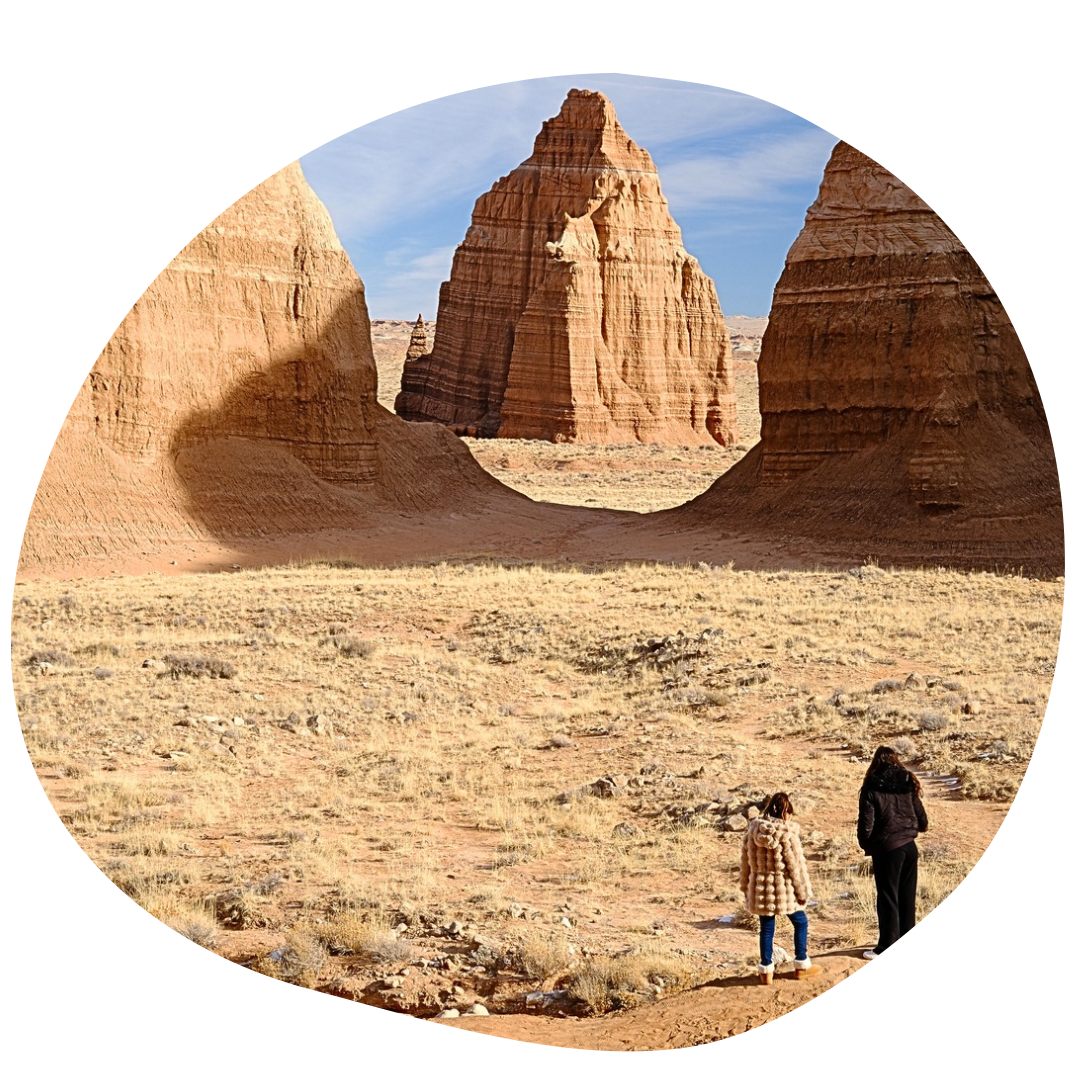
Best Things to Do With Family in Hanksville Utah
Discover why Hanksville, Utah is a must on your Southern Utah road trip. Explore geology, natural bridges, petroglyphs, and dinosaur bones, plus hidden gems like Moonscape Overlook and Cathedral Loop Road. Enjoy local eats at Duke’s Slick Rock Grill.
saltyvagabonds
Destinations
Travel Tips
Planning
About us
Saltyvagabonds
If you click on links we provide, we may receive compensation.
Hanksville has always intrigued me, not only for its secluded location on Google Maps but also for the rich archaeology and history that surrounds the town. With countless points of interest scattered around, Hanksville Utah offers a unique alternative for your next family vacation, away from the crowds of major national parks.
Goblin Valley State Park
Let’s start with Goblin Valley State Park. If you’re coming from Salt Lake City, this park is likely your first major stop aside from the San Rafael Swell on your journey to Hanksville.
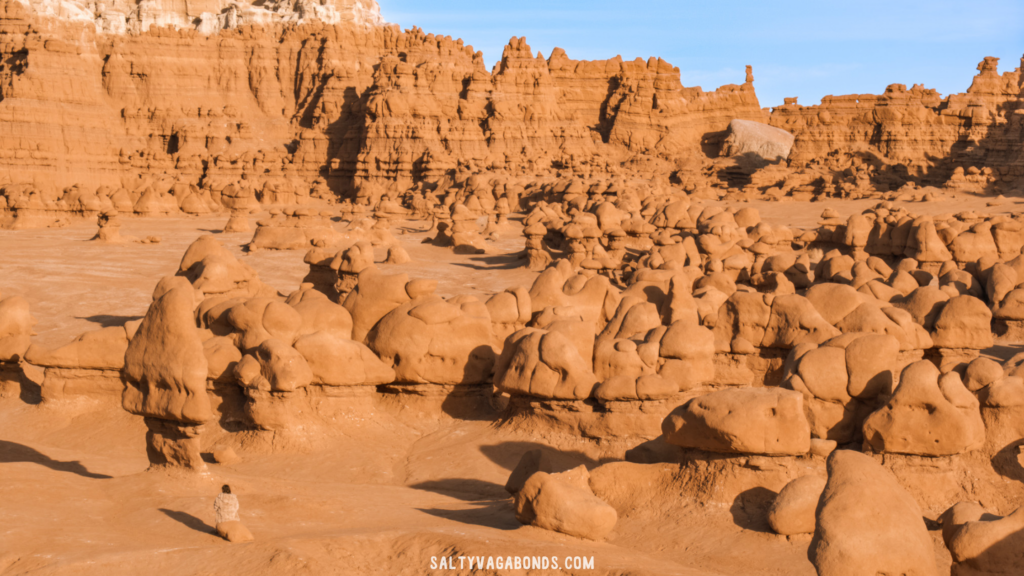
Hanksville Utah Gypsum Sink Hole by Salty VagabondsThe visitor center brings the San Rafael Swell to life, explaining its fascinating uranium mining history and the geological processes that shaped its impressive formations, including stunning slot canyons. We highly recommend stopping here to fully appreciate this remarkable natural attraction.
Capitol Reef National Park
After checking in at the visitor center and speaking with the ranger on duty, we planned our day at Capitol Reef National Park, focusing on the Temple of the Moon and Temple of the Sun.
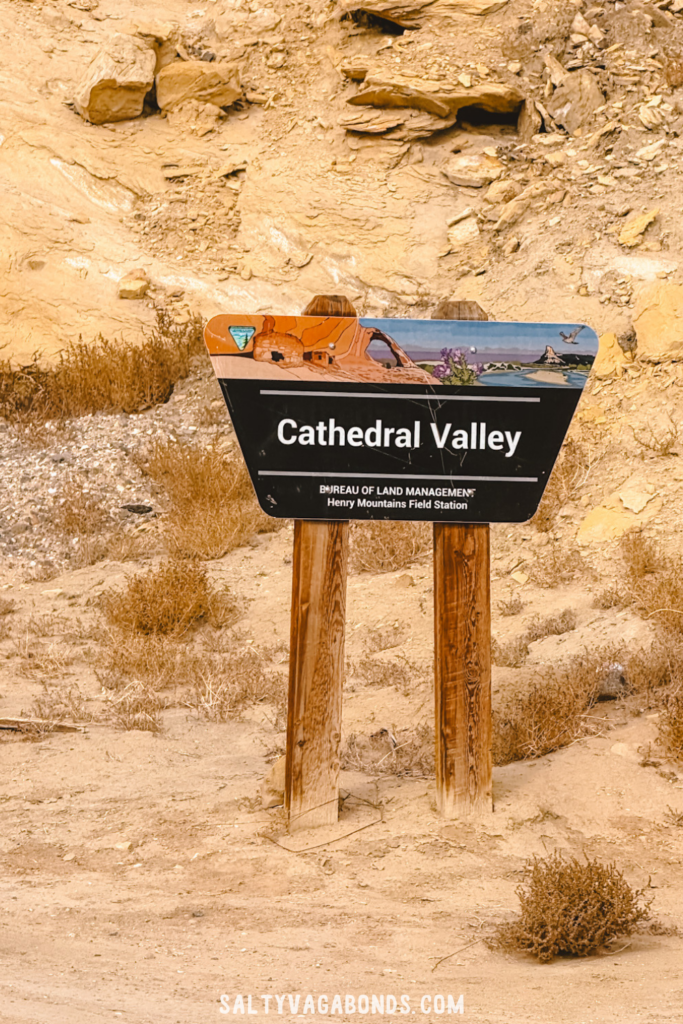
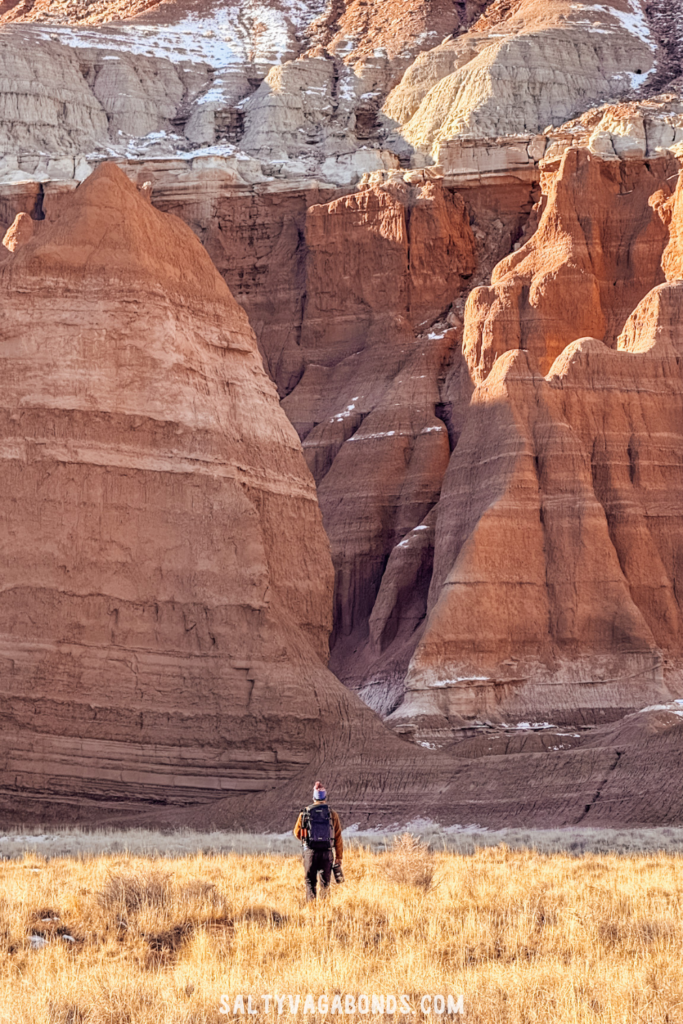
Although the Hickman Natural Bridge was initially on our list, snow and graupel forced us to change plans. We then took the dirt roads aptly named Cathedral Road leading to the temples and other intriguing rock formations.
Getting to Capitol Reef National Park
This windy, rocky road took us about 45 minutes to traverse; while a normal passenger car can handle it, a high clearance SUV or truck is recommended, especially during monsoon season that brings flash floods.
We didn’t locate the viral picture spot on our first visit, so after about 45 minutes of additional research using Google Maps and other sources, we identified two key locations:
• Viral/Famous Picture Location: GPS 38°26’28.8”N, 111°11’45.7”W
• Camping Spot (just outside the park): GPS 38°27’17.2”N, 111°10’49.6”W
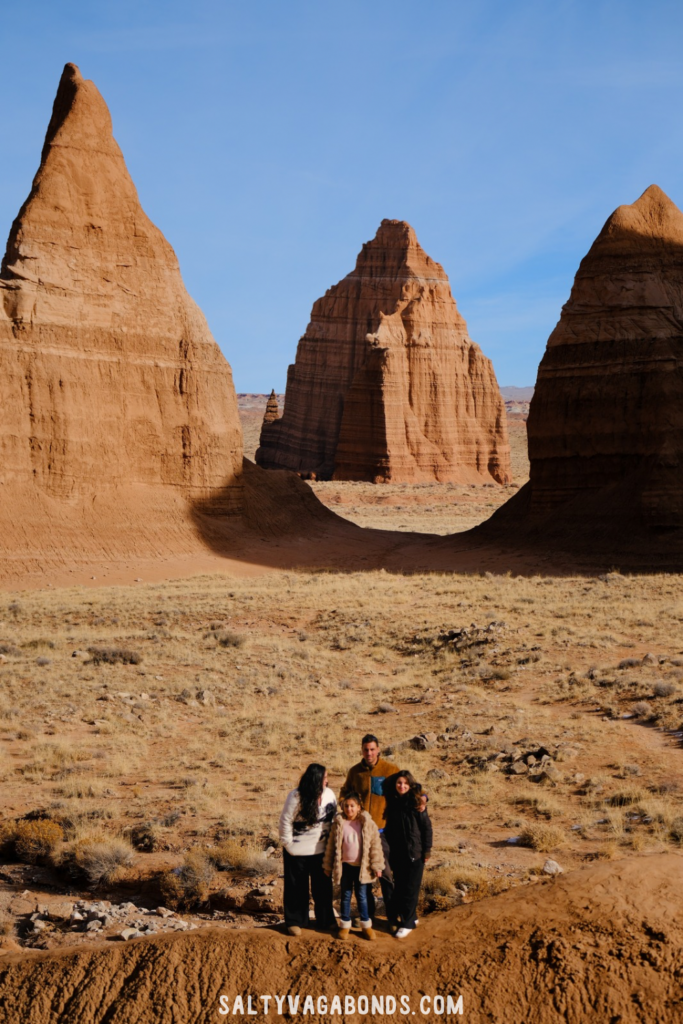
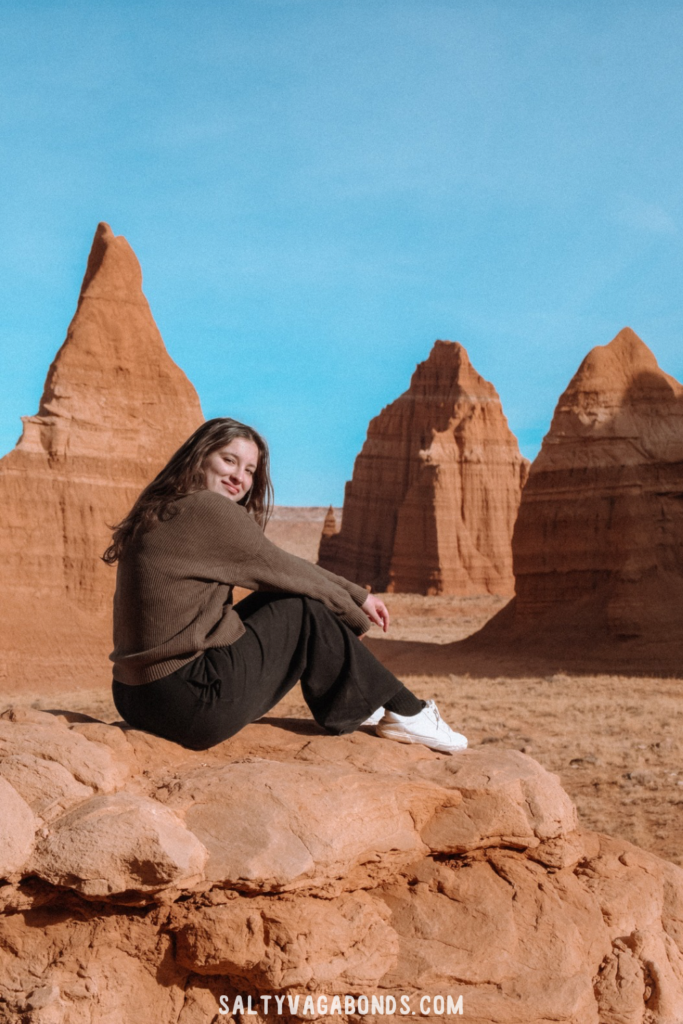
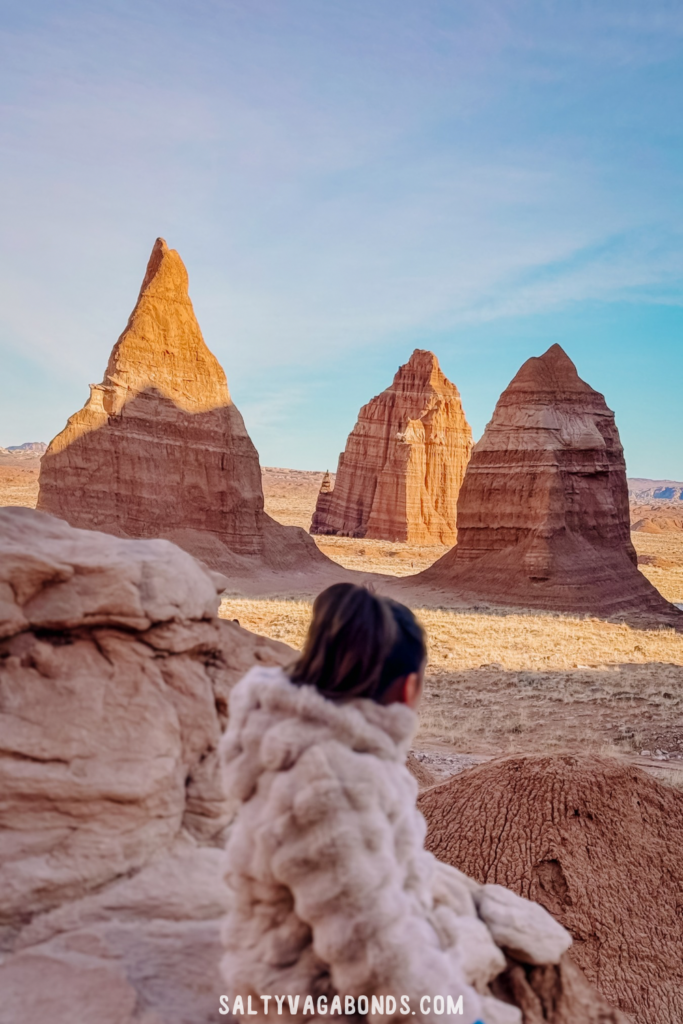
The Capitol Reef National Park Gypsum Sinkhole
After not finding the viral picture spot on our first day, we continued down Cathedral Road in search of other attractions and discovered the gypsum sinkhole. It’s just a 150-foot walk from the parking area.
This sinkhole formed when groundwater dissolved a buried deposit of gypsum from when the area was once an inland sea. The collapse of overlying rock layers created a dramatic sinkhole nearly 50 feet (15 m) in diameter and 200 feet (61 m) deep. It looks like a scene straight out of a sci-fi movie, a must see at Capitol Reef National Park.
The Capitol Reef National Park Walls of Jericho
Just further into the park, you’ll find the Walls of Jericho. This is a stunning area where you can get up close to monoliths formed from buff-pink Entrada Sandstone, deposited around 160 million years ago. If you have time, take the gorgeous drive to this canyon area, it’s well worth the adventure.
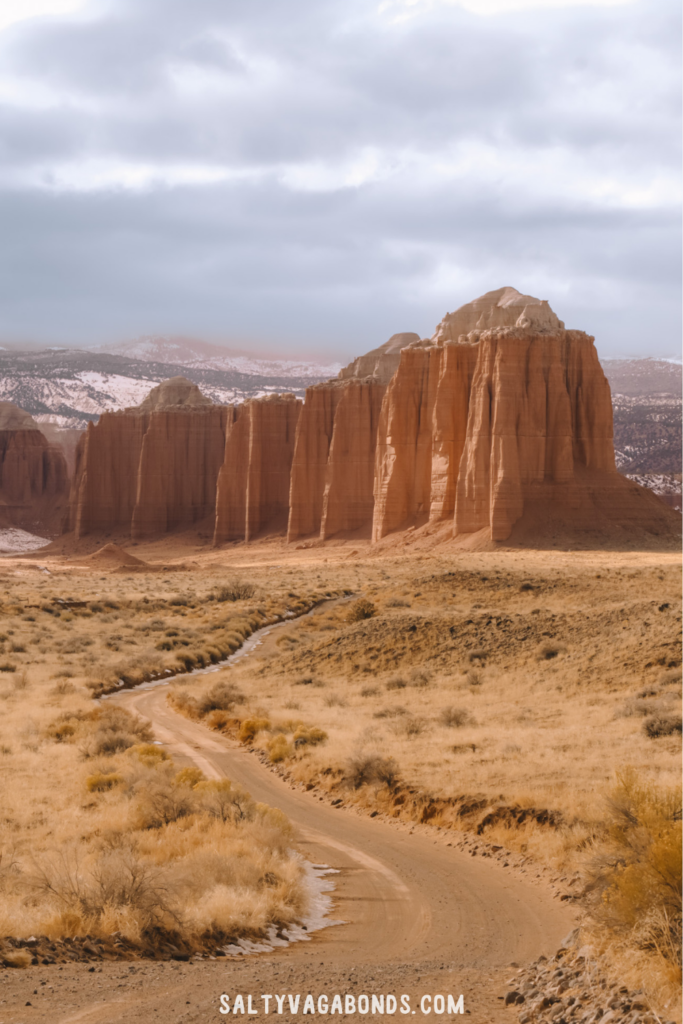
The Capitol Reef National Park Cathedrals Trail
A few hours before sunset, we made a quick stop at the Capitol Reef National Park Cathedrals Trail to see if this was the famous picture spot. We parked at GPS 38.4880188, -111.3531427 and hiked to the top to enjoy the breathtaking view before heading back to the paved road and continuing on a more than hour long dirt drive.
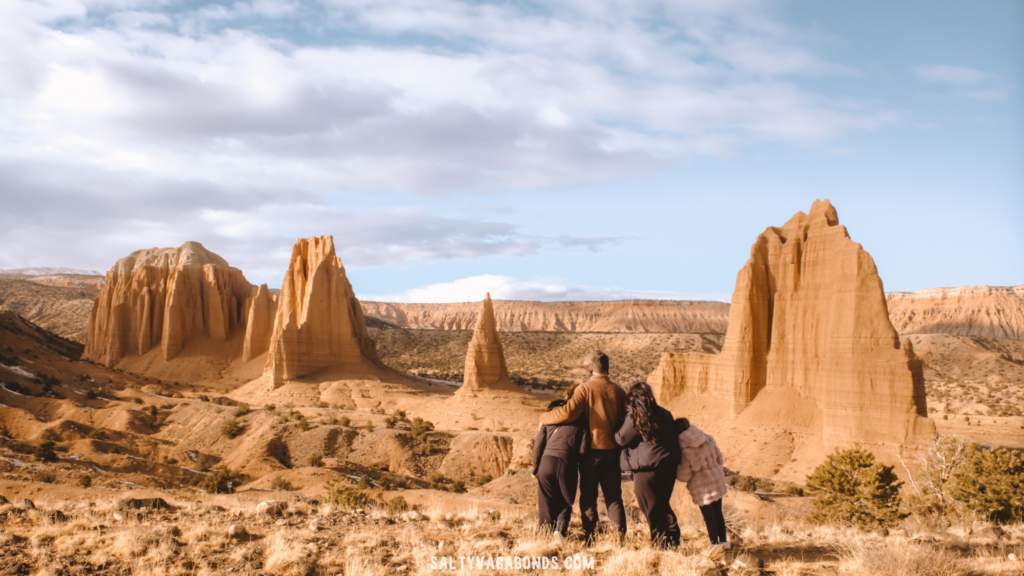
The view and climb were truly memorable, gorgeous and grandiose. Along the trail, we noticed plenty of mule deer signs, so your chances of spotting a herd are high, especially at dawn and dusk.
Utah has a way of captivating you, and even though we didn’t hit the viral picture spot that day, we made lasting memories, saw countless cows with newborn calves, and had an amazing day exploring the park.
The Moonscape Overlook aka Moon Overlook Vista Point
After leaving Capitol Reef National Park before sunset, we headed to Moonscape Overlook for a breathtaking valley view at dusk. But, where is moonscape overlook? It’s Located just minutes down Hwy 24 in the Factory Butte Special Recreation Management Area.
The drive was much easier and faster than to the Temple of the Sun and the Moon, thanks to better maintained dirt roads. While roads like Coal Mine Rd, Skyline View Rd, and Moon Overlook Rd can be rough and require cautious driving with a lower-clearance vehicle, the journey is well worth it.
Here’s everything you need to know to reach Moonscape Overlook using the most direct and hassle-free route:
- Hwy 24 Turn-off: GPS 38.367075N, -110.892366W
- 1st hard 90 degree turn: GPS 38.441438N, -110.880005W
- Slight Right Turn: GPS 38.448579, -110.852434
- Moonscape Overlook: GPS 38.452104N, -110.838019W
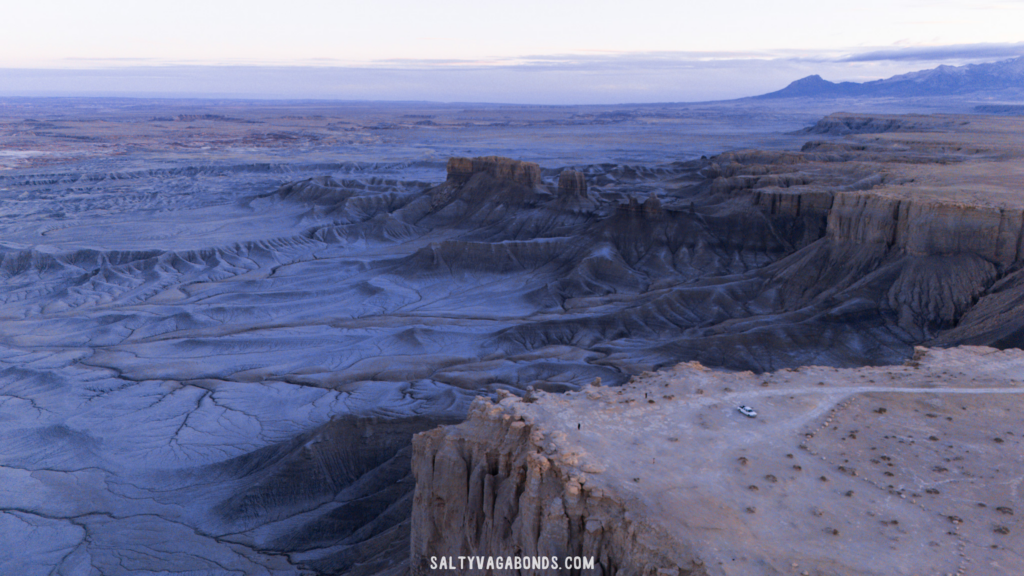
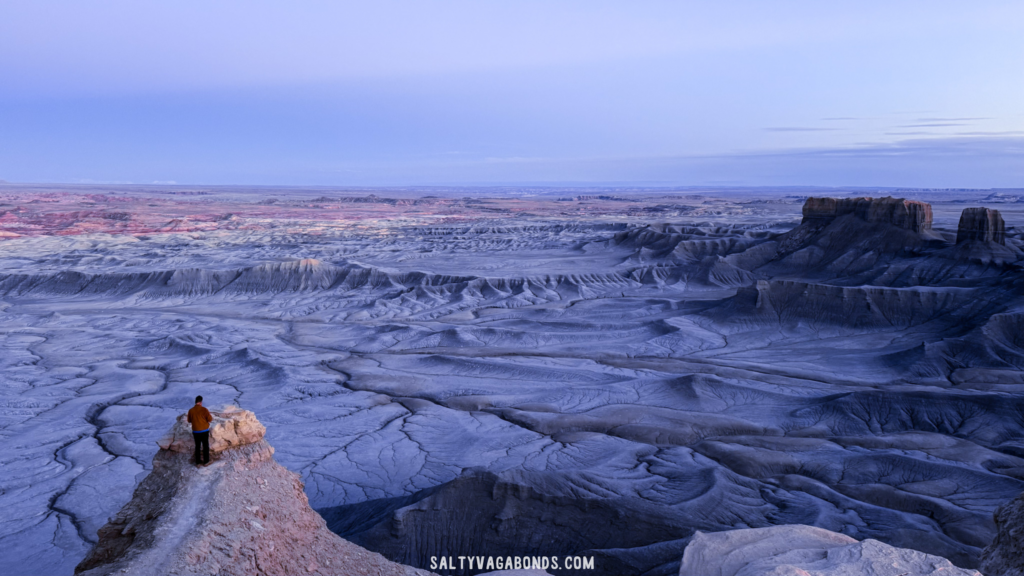
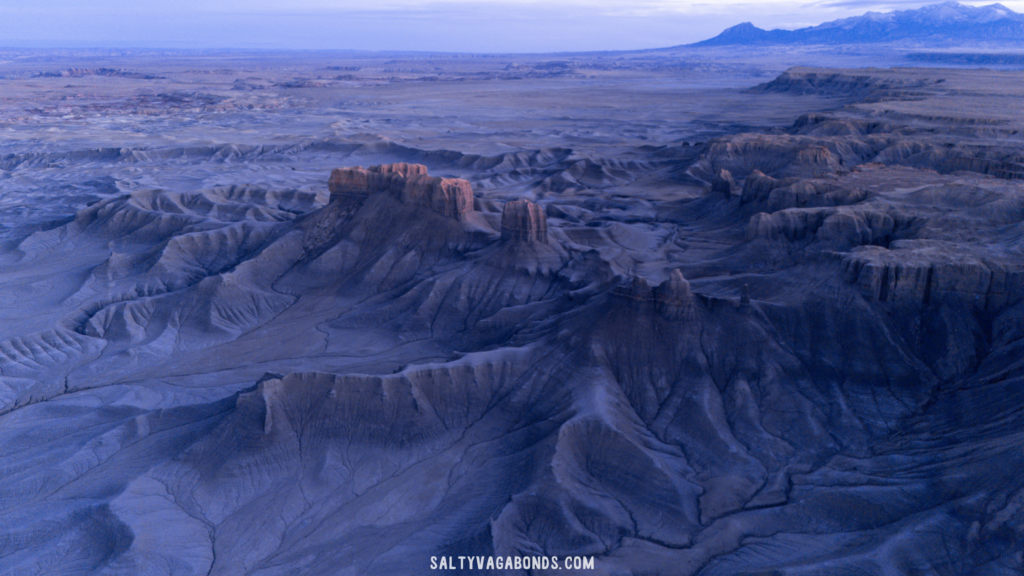
At the end of the road, you’ll notice a few old fire pits, just pick a spot to park and set up your tripod, you have reached the moonscape overlook Utah. The sunset view here is truly astonishing, arguably one of the prettiest desert vistas we’ve seen, better than even the Grand Canyon in our opinion.
Hanksville Utah Bentonite Hills and Capitol Reef National Park
Influencers have shared stunning drone footage and photos of Bentonite Hills, Utah, but the reality is a bit different from what you might see online. So, where is Bentonite Hills Utah?
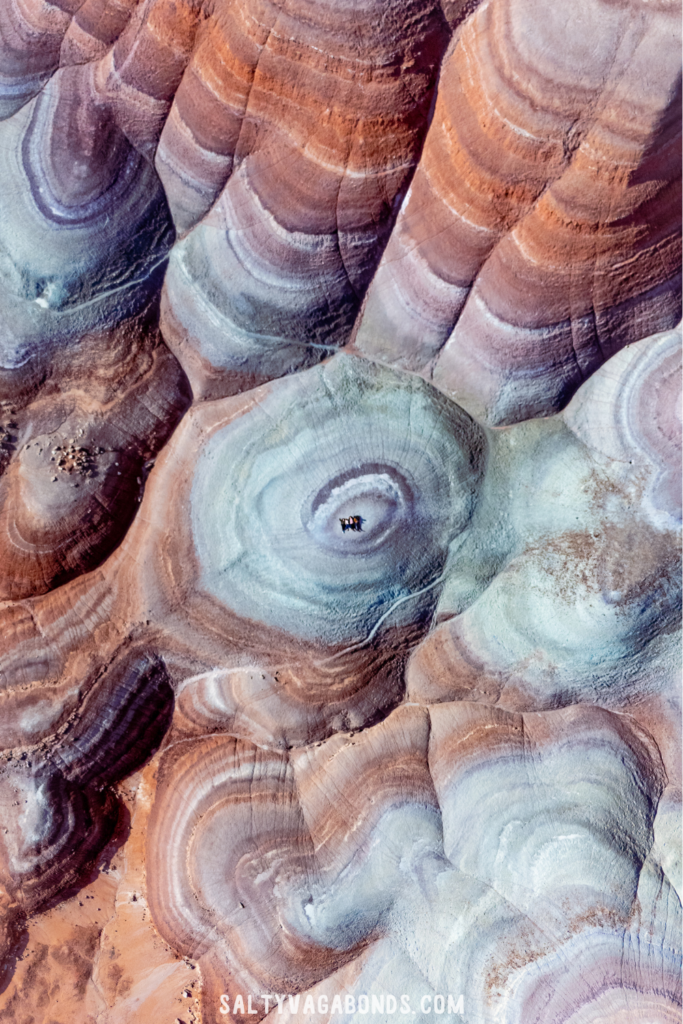
Within Capitol Reef National Park, the official Bentonite Hills area is located along Cathedral Valley Loop Road. To reach it by car, you’ll need to navigate a river crossing—unless you opt for the much longer detour. Since drones are prohibited in the national park, many influencers capture similar footage by visiting an alternate location.
The Alternate Location to Bentonite Hills, Utah
This alternative is in the same region as the Mars Desert Research Station (MDRS), on Cow Dung Road, which is managed by the local Bureau of Land Management (BLM). The road here is in better condition, allowing speeds of around 25 mph compared to the 10–15 mph on Cathedral Loop Road. You can park at the GPS coordinates 38.4126134, -110.7852316.
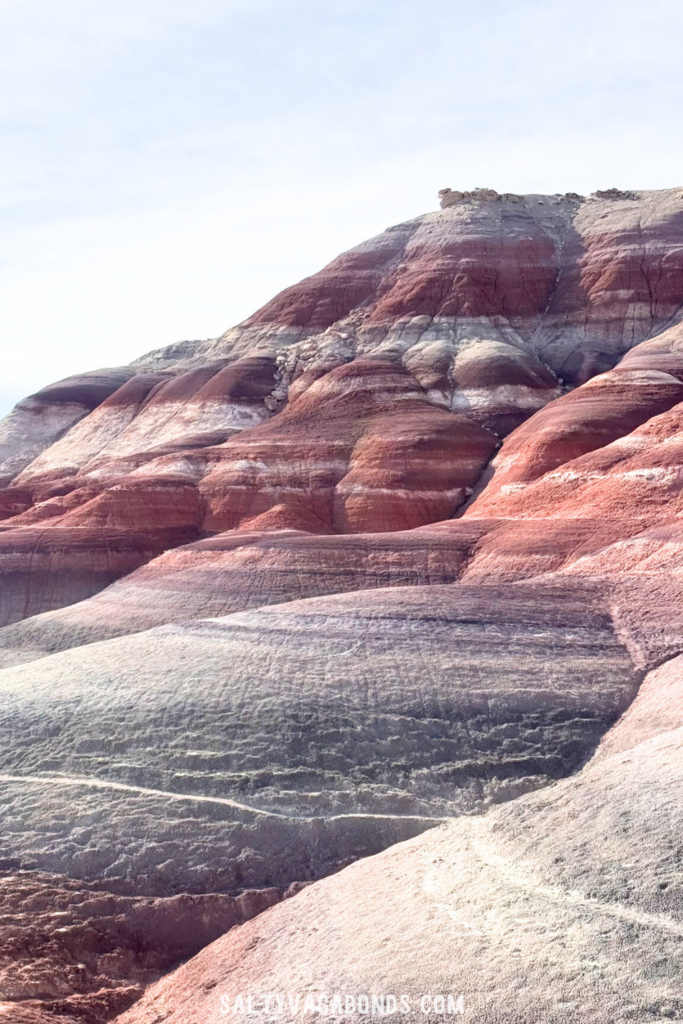

Once parked, the painted hills await. This area permits drone use, so you can take impressive photos and videos. Local hiking paths wind through the terrain, and the dome we explored was just a short hike, quarter-mile or so from the parking area.
The Spire (Long Dong Spire) in Hanksville Utah
The Spire, also known as Long Dong Silver, consists of a pair of striking black sandstone towers rising from the desert near Hanksville, Utah, a hidden gem on BLM land. It’s about a 20-minute drive from Hanksville along Hwy 24.
At a specific turn-off (GPS: 38°22’10.1”N, 110°50’20.7”W), follow a dirt road for about a mile to reach a small parking area. From there, you’ll walk another mile through flat desert terrain until the spire appears.
There’s no official trail or signage, so using GPS coordinates is essential. Save these points in your Google Maps before you lose cell service:
• Hwy 24 Turn-off: GPS 38°22’10.1”N, 110°50’20.7”W
• Parking Area: GPS 38.39010791679674, -110.83646131088537
• Spire: GPS 38°23’38.6”N, 110°49’56.4”W
We didn’t have time to explore the area in depth, but we passed the Hwy 24 turn-off several times. Upon reviewing satellite maps, it appears you might be able to get even closer, double tracks seem to run past the parking area.
Hanksville-Burpee Dinosaur Quarry
The Hanksville-Burpee Dinosaur Quarry is located just past The Mars Desert Research Station (MDRS) and the alternate Bentonite Hills location, about a 15-minute drive up the same road. Although we didn’t visit due to the absence of ranger-led tours at the time, the quarry is an exciting destination for families.
It offers a chance for kids to see real dinosaur bones and ancient remains actively uncovered at this archaeological site, where scientists have discovered over 1,000 bones (which have since been removed). Visitors are welcome to hike and explore the area, but digging and collecting fossils is prohibited.
Additionally, during the paleontologist-led dig season in May and June, the Bureau of Land Management (BLM) provides free guided tours, tours in the 2024 season were offered on May 13, May 20, June 3, June 10, and June 17.
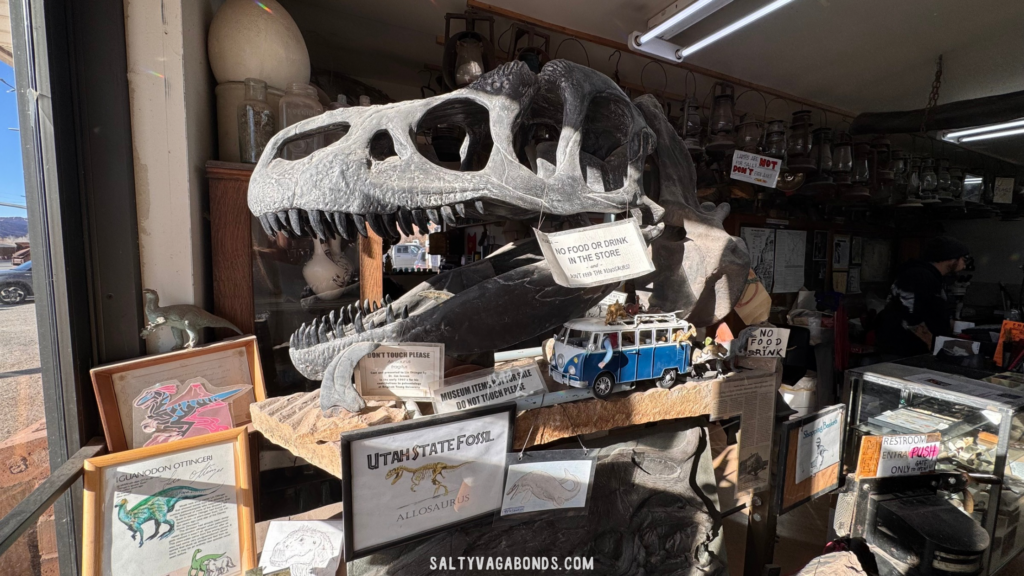
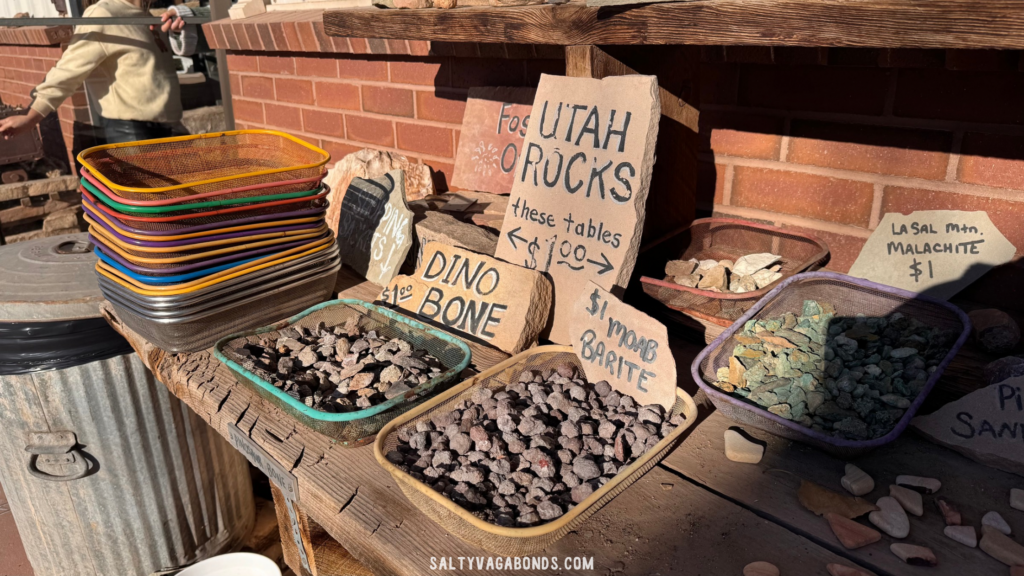
Horseshoe Canyon and The Great Gallery
While in Moab for a week, I was eager to hike Horseshoe Canyon and see the ancient archaeological sites of southern Utah. However, the long 5-hour drive and 7-mile sandy hike, especially as a solo journey, made me hesitate.
I recommend this hike if you’re visiting Hanksville Utah, as part of your exploration of Canyonlands National Park. The drive from Hanksville is much shorter, its about 1.5 hours, with 30 miles on dirt roads.

Once you begin the 700-foot descent, you’ll meander through a canyon once inhabited thousands of years ago. If you take your family, be sure to pack plenty of water and snacks for this long adventure.
Robbers Roost and Butch Cassidy
Southern Utah and Arizona are synonymous with Wild West legends, cowboys, outlaws, Native American conflicts, and a perceived lawlessness that have been immortalized in literature, movies, and TV shows like Buffalo Bill’s Wild West. This captivating mythos paints a picture of an uncharted frontier full of adventure, freedom, and larger than life tales.
If you want to experience a slice of that legendary past and get your boots dirty on the same soil as Butch Cassidy, head out to the famous Robbers Roost area and visit Butch Cassidy’s Cabin. It’s the perfect spot to introduce your kids to the real Wild West. According to legend, Butch Cassidy and the Wild Bunch would hide out here just east of the Henry Mountains after their heists, vanishing into the canyon’s rugged terrain like ghosts.
Butch Cassidy Cabin location
• GPS location: 38.361111N, -110.365833W
Hanksville Utah Canyoneering and Slot Canyons
Southern Utah offers exceptional canyoneering opportunities and stunning slot canyons. The geology in and around Hanksville has crafted unique trails and hikes that echo the beauty of famous sites like Antelope Canyon in Arizona, making for unforgettable adventures.
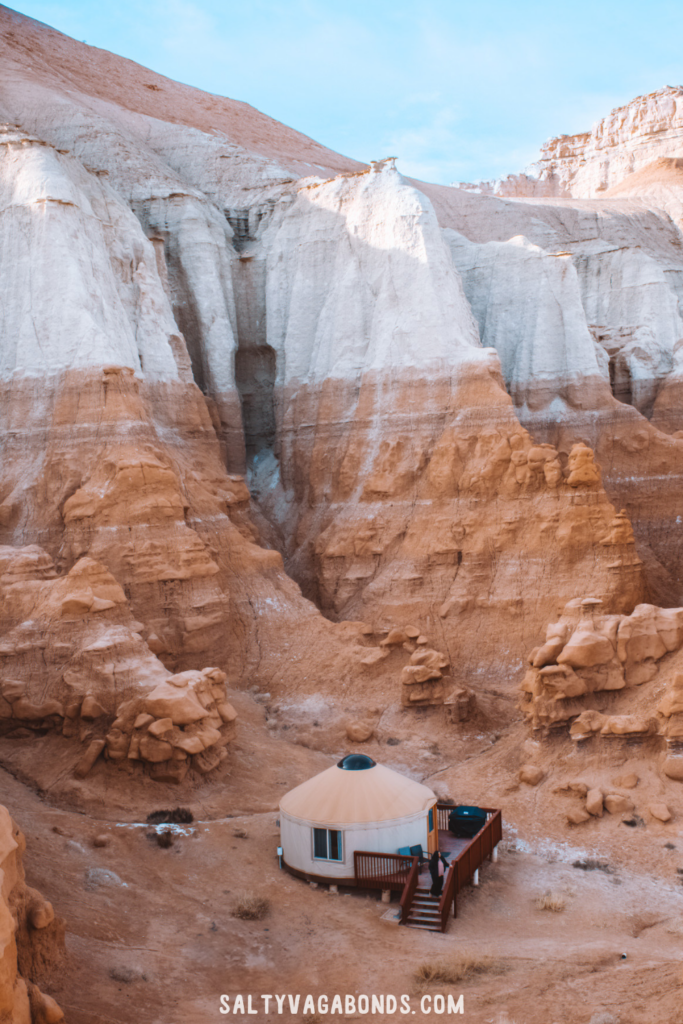
San Rafael Swell and Goblin Valley State Park Area
Ding and Dang Slot Canyons
These popular slot canyons, located just outside the state park, are accessible even for those with minimal skill level. The full route is considered semi-technical—rated as a Class 4 hike or 2A II on the ACA canyoneering scale, which may require down climbing short drops of around 10–12 feet.
BLM recommends ascending through Ding Canyon and descending via Dang Canyon, with the entire route spanning about 5 miles. A word of caution: entering slot canyons during heavy rain can lead to dangerous flash flooding, so please take appropriate precautions.
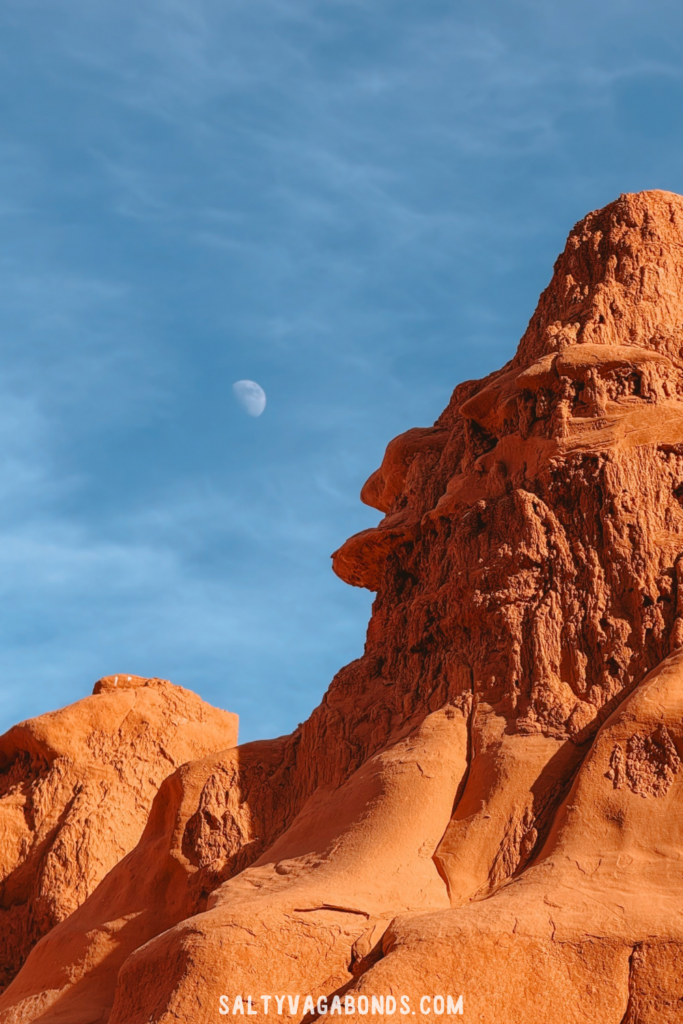
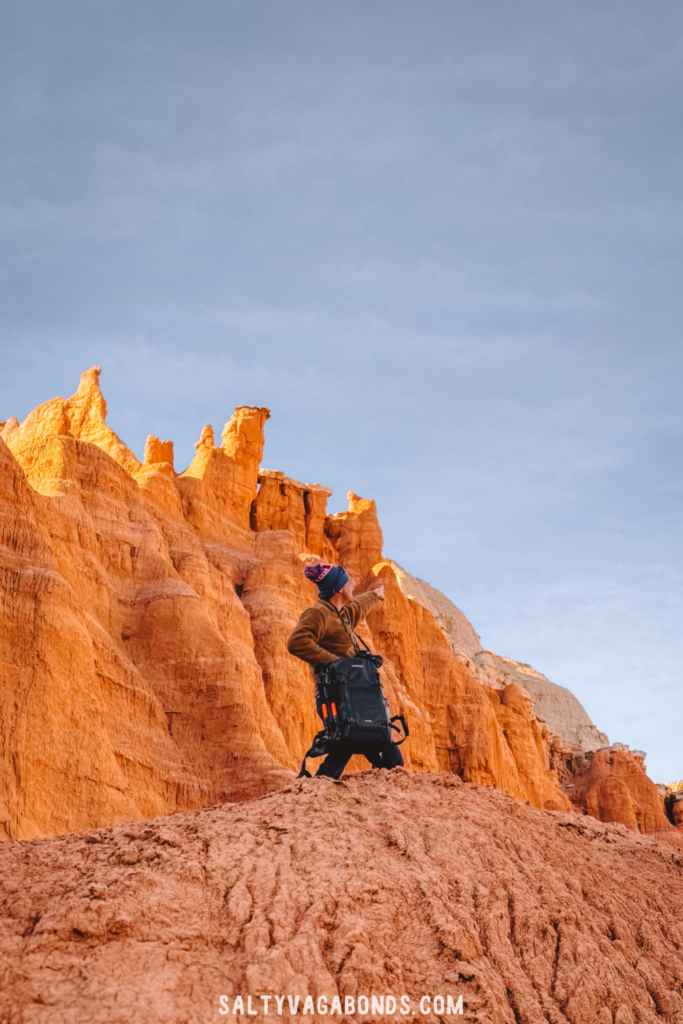
Little Wild Horse Canyon and Bell Canyon
This canyon, located along Wild Horse Road just outside the Goblin Valley State Park visitor center, comes before the Ding and Dang Slot Canyons. It’s an ideal trail for families with younger kids or anyone seeking a low skill level hike.
The entire slot canyon loop spans about 8.1 miles, which is doable for older children, but you can also opt for an out and back hike to enjoy the views without committing to the full loop. The main slot canyon leading to Little Wild Horse Canyon is about a 20–30 minute hike from the trailhead, while Bell Canyon sees fewer visitors due to its less impressive views.
Robber’s Roost Area
Some canyoneering enthusiasts might be intrigued to learn that Bluejohn, one of the area’s popular slot canyons, was the site of Aaron Ralston’s harrowing ordeal. Pinned by a fallen rock, Ralston was forced to amputate his own arm, a remarkable story later depicted in the film “127 Hours.”
Where to Stay in Hanksville Utah
After a long day of adventuring, we sought a place to rest in Hanksville, Utah, as our weekend wasn’t quite over, we still had more sites to see before heading back to Moab. We chose to stay at the Muddy Creek Mining Company cabins for comfort, but for a truly unique Airbnb experience, check out the two charming yurts nestled among the Goblin Valley State Park rock formations.
Muddy Creek Mining Company Family Cabin
We chose the family cabin at Muddy Creek Mining Company for several reasons. First, it’s brand new, perfect for our family blog to showcase its modern charm. The cabin features a spacious king-size bed for adults, a large bunk bed for the kids (or additional adults), and a comfortable sofa bed that easily accommodates a family of six.
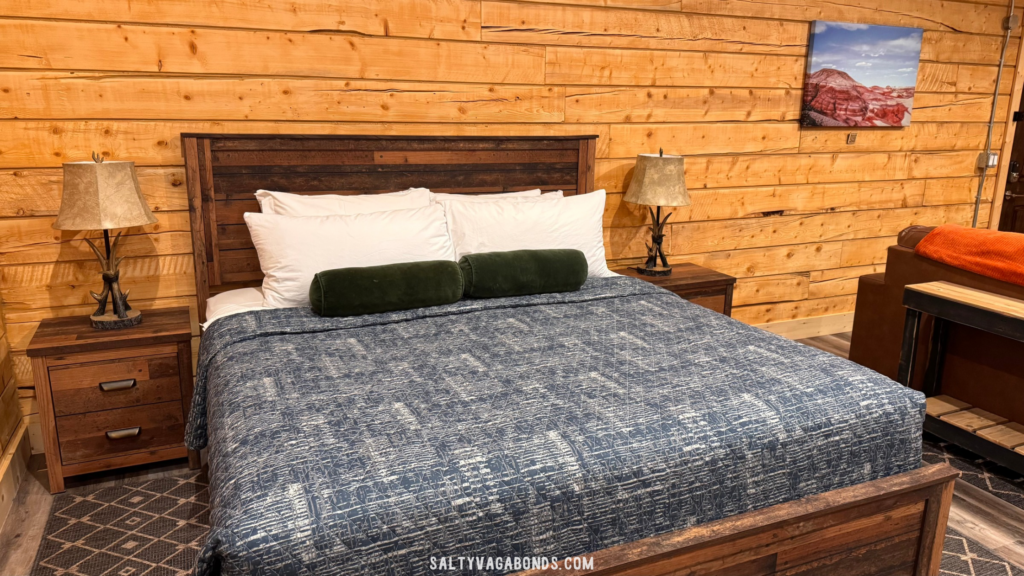
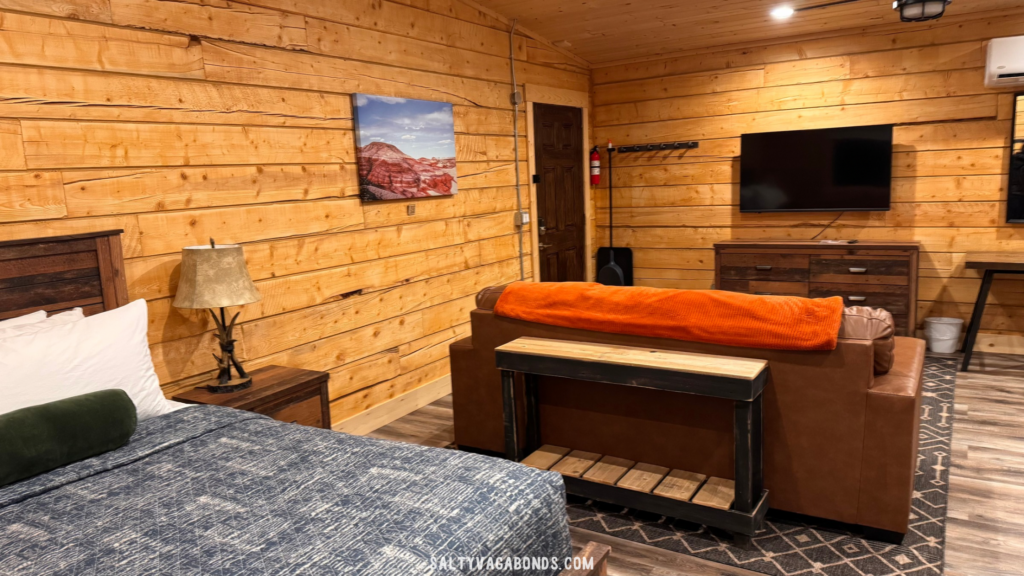
The well-equipped kitchen comes with utensils, pans, a microwave, fridge, ice maker, coffee cups, and plates, though it lacks a cooktop and oven, the outdoor gas grill more than makes up for it. Although we only stayed one night, the cabin’s inviting amenities make it an ideal spot for a week long getaway to explore the area.
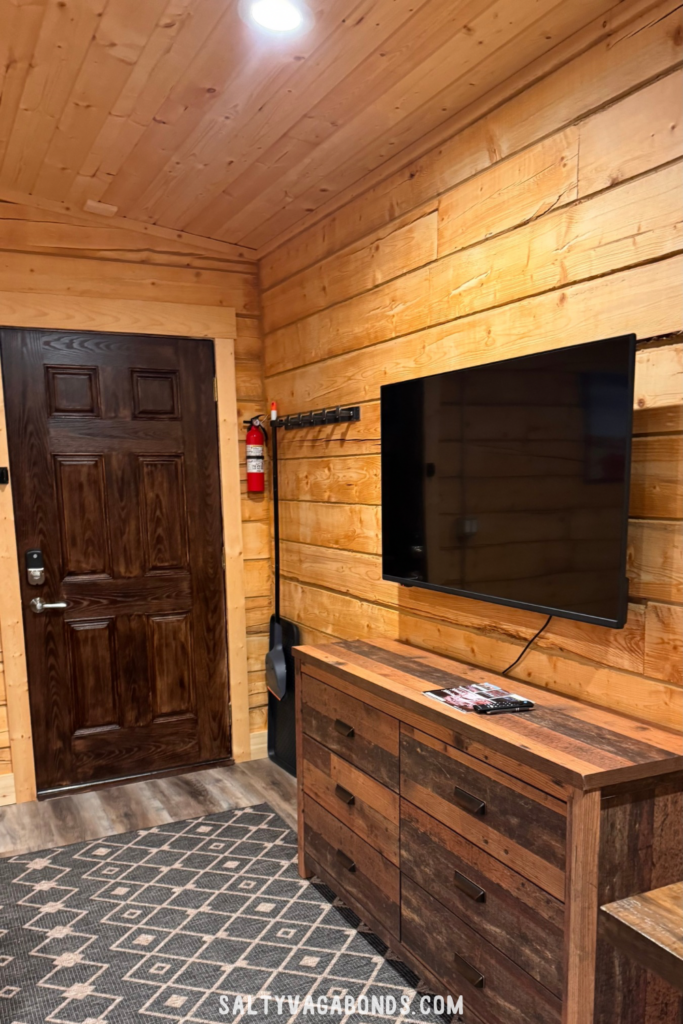
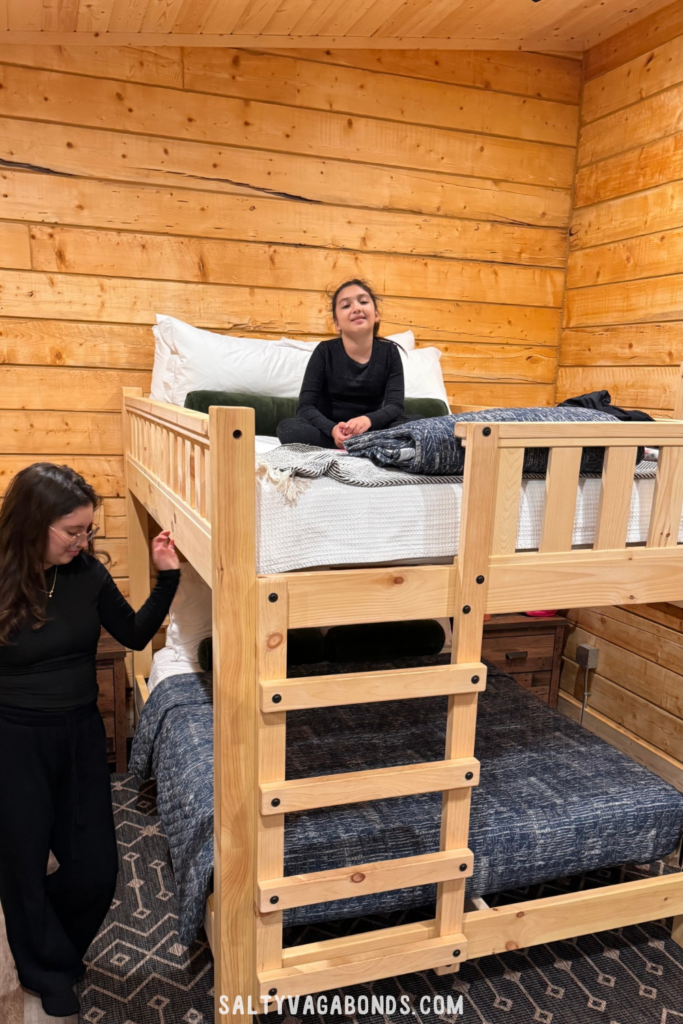
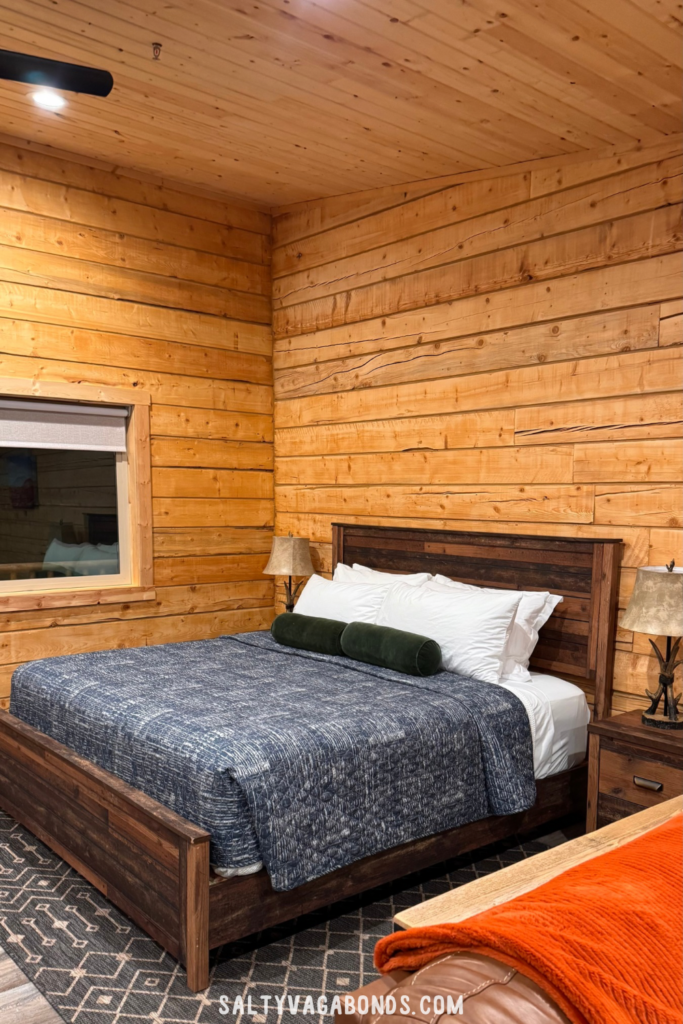
Hanksville Utah Restaurants
Hanksville is a small town of about 200 people, so dining options for dinner are limited. During our visit, Duke’s Slickrock Grill looked like the top choice, and locals rave about the pizza at Bull Mountain Market. Unfortunately, Duke’s Slickrock Grill was closed when we arrived, and a sign directed us to “Stan’s Burger Shak” at the Silver Eagle Gas Station on Hwy 95, which was open.
Stan’s Burger Shak
After our disappointment at Duke’s, we headed to Stan’s Burger Shak. Located within the Silver Eagle gas station. This Hanksville Utah store is complete with snacks, grocery items, and even fish bait for Lake Powell, it serves as the local supply post.
Stan’s offers a full menu of burgers, sandwiches, wraps, kids’ meals, salads, and sides like fries, fried mushrooms, and the standout “Duke Fries.” These Duke Fries, resembling tater tots with jalapeño bits, aren’t overly spicy but pack great flavor, a unique treat we hadn’t seen anywhere else.
It’s a simple burger shack in a very small town, so don’t expect luxury, but the food tastes just like your favorite burger spot. The staff was friendly, and after a long, exhausting day, we enjoyed a satisfying meal at Stan’s.
Hanksville Utah With Kids
We visited in January during the peak slow season and had an overall decent experience, but there are a few things influencers often overlook. For example, while the scenic drives around the national park and between locations can be beautiful, they aren’t exactly fun for the kids. It’s important to plan for long car rides and consider ways to keep your little ones entertained during those stretches.
Fruit Picking at Capitol Reef National Park
I’m not going to lie, I wish we were here during harvest season so we could pick fruit during our adventure. Capitol Reef National Park features numerous orchards established by early pioneers. During harvest season, you can enjoy ripe fruit on-site for free, or purchase additional fruit at extra cost. For more details, check out the National Park Service website here.
Long Drive Times on Dirt Roads
While our photos capture great memories, they don’t tell the story of the long, monotonous drives on dirt roads and the boredom that our kids experienced. Without proper entertainment, even the free-ranging cows provided only a brief distraction.
For example, it took 1 hour and 53 minutes to drive 36 miles from the Capitol Reef National Park Visitor Center to the Cathedral of the Sun and Moon, and another 45 minutes to return to the paved road. That’s nearly 2 hours on rough dirt roads to reach the famous Temple of the Moon and Temple of the Sun photo spot.
Be Prepared
Many roads in these remote areas are poorly maintained, so extra water and snacks in your car can be a lifesaver. During the off season, you will likely have these vast BLM lands mostly to yourself, so be sure to download offline maps and GPS locations, as cell service is minimal or non existent.

Hanksville Utah Itinerary – 6 Day Family Adventure
Day 1: Arrive in Hanksville and kick off your trip with a drive to Moonscape Overlook for a breathtaking sunset (a 34-minute drive each way).
Day 2: Head along Wild Horse Road to explore the Alternate Bentonite Hills first, then visit the Hanksville-Burpee Dinosaur Quarry in the afternoon to hunt for exposed bones, and finish with epic photos at The Spire (Long Dong Spire) around sunset.
Day 3: Spend the day at Capitol Reef National Park. Start at the Visitor Center to pick up junior ranger booklets and explore the orchard (free on-site fruit, extra cost for take-home fruit), then visit petroglyphs, Hickman Natural Bridge, and cruise along Cathedral Valley Loop Road.
Day 4: Explore Goblin Valley State Park and the San Rafael Swell. Enjoy kid-friendly slot canyons like Little Wild Horse and Bell Canyon, and consider a short hike into The Goblin’s Lair if you have canyoneering gear.
Day 5: Embark on an all-day adventure to Horseshoe Canyon and The Great Gallery—a remote, lesser-visited area of Canyonlands National Park featuring incredible, well-preserved rock art.
Day 6: Wrap up your trip with a visit to Robbers Roost and Butch Cassidy’s Cabin, where you can immerse yourself in Wild West lore while traversing 30 miles of rugged dirt roads.
Should I visit Hanksville Utah on a Southern Utah Road Trip With My Family?
You definitely should visit Hanksville, Utah, on a Southern Utah road trip with your family! The area’s unique geology offers natural bridges, petroglyphs, and even dinosaur bones, all in one day or spread over several days.
Hanksville is a hidden gem in Utah with must-see spots like Moonscape Overlook and the Cathedral Loop Road in Capitol Reef National Park. Visit during the best time of year, when you can even pick fruit and enjoy a meal at Duke’s Slick Rock Grill.
Leave a Reply Cancel reply
You must be logged in to post a comment.
Our Story
Message in a
bottle?
Join our Newsletter! We're sharing monthly tips & tricks for travel, discounts & more.
Travel Blogs
About us
Contact
Tips & Tricks
hello@saltyvagabonds.com
Link in Bio
Work With Us
SpaceA Military Flights
Santa Fe Travel Guide
Visit Disney Aulani Hawaii
Family Packing Guide
Our Photography Gear
Plan Your Travel
See you soon!
Planning
Tips
Destinations
Oceania
North America
Europe
Asia
Bali
Japan
Korea
Malaysia
singapore
Thailand
Vietnam
France
U.K.
Germany
Canada
Mexico
usa
French Polynesia
Micronesia
Hawaii
Guam
Indonesia
All Travel Blogs
Destinations
Planning
Tips
Destinations
Travel Tips
Planning
About us
Hotels
via Booking.com
Car Rental
Book a Bus/Train/Transfer
Find Cheap Flights
Get ESIM or SIM Card
Easy Currency Exchange
Book Tours & Attractions
Get Travel Insurance
via Discover Cars
via Skyscanner
via 12Go
via Wise
via Viator
via Visitors Coverage
via SimOptions